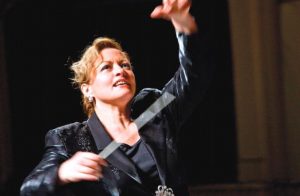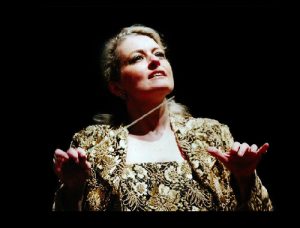Cien Años: A Paean to Piazzolla and Tango from Conductor Gisèle Ben-Dor and
Bandoneón Soloist Juanjo Mosalini

CD Featuring Pro Arte Chamber Orchestra of Boston Commemorates Influential Argentine Composer’s 100th Anniversary with Four World Premieres
“I have a vision that my work will still be heard in the year 2020 and also in the year 3000,” Astor Piazzolla once brazenly predicted. So far, the man who revolutionized the tango sounds like a prophet.
“Cien Años” is not only an exquisitely expressive celebration marking the centennial of Piazzolla’s birth, the CD honors more than one man’s immeasurable musical contributions. For Uruguayan-born conductor Gisèle Ben-Dor, a fierce champion of Latin American composers, equally important as paying homage to the Argentine nuevo tango legend was capturing the unique, mesmerizing performance of bandoneón player/arranger/composer Juanjo Mosalini on Piazzolla’s most ambitious work—the Aconcagua concerto—and showcasing an exciting new piece she commissioned from this extraordinary musician. Mosalini’s title composition, Cien Años, is in turn a heartfelt 100th birthday tribute to his own grandfather and the legacy of his family’s four generations of bandoneónists.
Ben-Dor and Mosalini, each an acclaimed performer in their own right, have worked together frequently on world stages. Their collaborations expose the heart of tango as
Piazzolla imagined it: cosmopolitan, an emotional roller coaster, technically virtuosic, savage and tender.
Along with Piazzolla’s monumental concerto, the CD features four world premieres. It was recorded at a January 2020 live performance with Boston’s Pro Arte Chamber Orchestra at the Sanders Theatre in Cambridge, MA, and is scheduled for release on August 5 from Centaur Records. Ben-Dor has previously released a CD for Centaur and another one is upcoming soon after the release of Cien-Años .
It is worth mentioning that Ben-Dor and Mosalini have recorded together for Delos, including two world premieres, Piazzolla’s classically inspired “Tres Movimientos Sinfonicos: Buenos Aires” and Argentine Academy Award winner Luis Bacalov’s “Triple Concerto for Bandoneon, Piano and Soprano”.
In addition to the debut of Cien Años, the concert premiered Mosalini’s Tomá, Tocá, yet another tribute, this one to renowned guitarist Tomás Gubitsch, who played with both Piazzolla and Mosalini’s father Juan Jose. Rounding out the program: his fresh arrangements for Piazzolla’s Four Seasons of Buenos Aires and Libertango. The Four Seasons showcase the unique, original idea of playing the work in one single movement, where the seasons follow each other most fluently, as is sometimes the case with nature itself.
Called “an exceptionally lively and intelligent musician” by the Boston Globe, Ben-Dor constantly proves that in a still male-dominated profession, a woman’s place is on the podium. A protégé of Leonard Bernstein, she is widely regarded as one of the world’s finest exponents of the repertoire of Ginastera, Revueltas, Villa-Lobos and Luis Bacalov, as well as Piazzolla. Her list of trailblazing recordings of Latin-American music, almost always world premieres, continues to grow and includes a CD of Ginastera’s vocal music (“The Vocal Album”) with Placido Domingo,
She has been a guest conductor with ensembles and orchestras around the world, including the New York Philharmonic, London Symphony, London Philharmonic, Los Angeles Philharmonic, Houston Symphony, Orchestre de la Suisse Romande, New World Symphony, Israel Philharmonic, Jerusalem Symphony and the Israel Chamber Orchestra. Maestra Ben-Dor is currently Conductor Laureate of the Santa Barbara Symphony and Conductor Emerita of the Boston Pro-Arte Chamber Orchestra.
A charismatic, smoldering presence on stage, Mosalini “is a one man tour de force” “[He] astonishes with his facility and musicianship…and is another unsung musical star.” The supremely gifted bandoneón virtuoso has performed with prestigious musicians, ensembles and orchestras worldwide, among them the London Symphony, Rotterdam Philharmonic, Orchestre Philarmonique de Radio France Israel Symphony, Seoul Philharmonic, the Bern Symphony, the Winterthur Symphony, the Orchestre de Bretagne, Santa Barbara Symphony, the Orchestra del Teatro Massimo Di Palermo and the Budapest Concert Orchestra.
“A few years ago, after I heard Juanjo perform the Aconcagua I was so electrified that I told him” you have to record this,” Ben-Dor recalls. “To me it was the ultimate, something extraordinary. For the album, I commissioned him to write an original piece and asked him to arrange the Four Seasons to highlight the bandoneón rather than the usual arrangement for violin.”
Much like Piazzolla, Mosalini shows his one-of-a-kind artistry and inventiveness as both an interpreter, playing with absolute authority over this difficult instrument, and as a composer. In the lyrical Cien Años, Mosalini uses the familiar language of the tango but takes it in new, unexpected directions. “I dedicated the piece to my grandfather and it has classical tango elements that reflect my culture, my heritage and what I listened to. The melody has a certain nostalgic feel as well as a lot of joy and hope,” he says. Ben-Dor adds
“it was a fortuitous coincidence that both Piazzolla’s anniversary and Juanjo’s celebration of his grandfather’s anniversary came to fall under the Cien Años , A Hundred Years, idea. It adds a lot of meaning, where both dedicatees are remembered nostalgically as well as virtuosically”.
Piazzolla may cast a giant shadow over the tango genre, but Mosalini is clearly up to the task of making this music his own. He puts his stamp on Four Seasons by creatively combining Piazzolla’s four separate movements into one seamless work with the bandoneón taking center stage. In Mosalini’s reimagining of the cadenza from Aconcagua, the concerto becomes a dialogue between two bold tango masters from different generations. He is a native improviser speaking in the language of Piazzolla.
“During the centenary celebrations around the world, everybody’s trying to play Piazzolla’s music the way he did,” says the recording’s Special Consultant Pablo Aslan. “What this CD does is explore his repertoire in different ways and from a different angle. Mosalini is an incredible musician with great ideas and mind blowing technique. When you hear his music on this album, you can hear all of his influences, including the music that his father played in his sixties. It’s almost like a parallel road to Piazzolla.”
On “Cien Años,” Ben-Dor, Mosalini and the Pro Arte Chamber Orchestra of Boston seize the opportunity to add their own artistic creativity atop the foundation laid by the architect of Nuevo Tango and celebrate the enduring legacy of this musical genius.

 Uruguay immigrant Gisèle Ben-Dor was one of 34 naturalized citizens who received the “Great Immigrant, Great American” award, which celebrates the many ways in which immigrants enrich culture, strengthen democracy and improve society through their lives, work and examples.
Uruguay immigrant Gisèle Ben-Dor was one of 34 naturalized citizens who received the “Great Immigrant, Great American” award, which celebrates the many ways in which immigrants enrich culture, strengthen democracy and improve society through their lives, work and examples.



 Gisele Ben-Dor is listed as one of the best conductors in the world!
Gisele Ben-Dor is listed as one of the best conductors in the world!